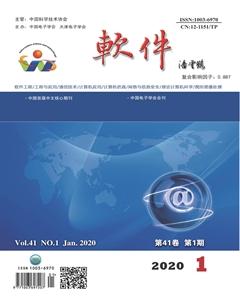基于CTA的个体化脑动脉瘤的流固耦合分析及其临床应用
陈广新 赵东良 郭金兴



摘 要: 探讨基于CTA的个体化脑动脉瘤的流固耦合分析,为临床应用提供帮助。利用真实患者的脑动脉瘤DICOM格式影像检查数据,利用MIMICS软件进行三维重建血流模型、应用3-matic软件进行修复、光顺,应用ANSYS ICEM CFD软件生成流体的有限元模型,利用HYPERWORKS SimLab软件基于流体模型构建动脉壁有限元模型,使用ANSYS FLUENT+Transient Structural进行双向流固耦合计算一个心动周期的动脉瘤血流动力学参数。本文有限元模型的构建方法可有效的分析动脉瘤的血流动力学参数,为临床提供科学的理论指导。
关键词: 脑动脉瘤;血流动力学;计算流体力学分析
中图分类号: TP319 文献标识码: A DOI:10.3969/j.issn.1003-6970.2020.01.020
本文著录格式:陈广新,赵东良,郭金兴,等. 基于CTA的个体化脑动脉瘤的流固耦合分析及其临床应用[J]. 软件,2020,41(01):97101
【Abstract】: The fluid-solid coupling analysis of individualized cerebral aneurysms based on CTA was discussed to provide help for clinical application. Using DICOM format image examination data of cerebral aneurysms of real patients, three-dimensional blood flow model reconstruction is performed by MIMICS software, repair and smoothing are performed by 3-matic software, finite element model of fluid is generated by ANSYS ICEM CFD software, finite element model of arterial wall is constructed by HYPERWORKS SimLab software based on fluid model, and bidirectional fluid-solid coupling is performed by Ansys Fluent+Transient Structure to calculate hemodynamic parameters of aneurysm in one cardiac cycle. The construction method of finite element model in this paper can effectively analyze the hemodynamic parameters of aneurysm and provide scientific theoretical guidance for clinic.
【Key words】: Cerebral aneurysm; Hemodynamics; Computational fluid dynamics analysis
0 引言
颅内动脉瘤(intracranial aneurysms,IA)是一种严重危害健康的脑血管疾病,普通人群发病率约为3.2%[1]。IA一旦破裂,致残率及致死率非常高[2]。随着医学影像诊断技术的提高,IA大多可准确诊断[3]。计算流体力学(computational fluid dynamics,CFD)对血流动力学的研究提供了可以借鉴的方法,大大的拓宽了血流动力学的研究途径。血流动力学因素包括壁面压力、血流速度、壁面剪切应力等被认为是影响动脉瘤的发生发展的重要因素。应用计算流体力学对动脉瘤进行血流动力学研究,具有可控性好、稳定性高、计算准确等优势。国内外学者已经基于CFD方法对血流动力学进行了大量的研究[4,5]。以往的研究偏重于流体力学分析,对动脉瘤进行流固耦合分析较少。本文基于个体化动脉瘤CTA影像数据,分别构建血流、动脉壁的有限元模型,采用双向流固耦合计算,获得一个心动周期的血流动力参数,分析动脉瘤的血流动力学特点,为临床的研究提供借鉴。
1 材料与方法
1.1 图像采集
采集牡丹江医学院附属红旗医院一名动脉瘤患者未破裂脑动脉瘤影像数据,患者知情同意,经医院伦理委员会批准。使用日本东芝Aquilion 64层螺旋CT行头部CTA检查,检查数据以DICOM格式输出。
1.2 三维模型构建
使用MIMICS 21.0软件手动导入采集的动脉瘤DICOM格式文件。采用阈值分割、区域增长等算法,计算三维模型,获得动脉瘤3D模型,并经手动分割,保留载瘤动脉。将获得的3D动脉瘤模型以stl格式导入正向工程软件3-matic进行光顺、表面网格优化,最终获得包括动脉瘤的血流3D模型(图1)。动脉壁的模型须依此生成。
1.3 有限元网格生成
动脉壁网格:基于动脉瘤stl格式直接生成动脉壁网格。将.stl格式的动脉瘤模型导入SimLab软件(美国Altair公司有限元网格划分软件)中,生成三层的棱形网格结构,壁厚0.2 mm(图2)。
動脉瘤网格:应用ANSYS ICEM CFD(美国ANSYS公司流体网格划分软件)软件划分动脉瘤.stl格式模型。流体采用四面体类型、为保证计算精度边界层5层加密(图3)。
[8] Fatma Gulden Simsek, Young W. Kwon. Investigation of material modeling in fluid–structure interaction analysis of an idealized three-layered abdominal aorta: aneurysm initiation and fully developed aneurysms[J]. J Biol Phys, 2015, 41(2): 173-201.
[9] Paris Perdikaris, Joseph A. Insley, Leopold Grinberg, Yue Yu, Michael E. Papka, George Em. Karniadakis. Visualizing multiphysics, fluid-structure interaction phenomena in intracranial aneurysms[J]. Parallel Comput, 2016, 55: 9-16.
[10] Tianlun Qiu, Guoliang Jin, Wuqiao Bao, Haitao Lu. Intercorrelations of morphology with hemodynamics in intracranial aneurysms in computational fluid dynamics[J]. Neurosciences, 2017, 22(3): 205-212.
[11] Kristian Valen-Sendstad, Aslak W. Bergersen, Yuji Shimogonya, et.al. Real-World Variability in the Prediction of Intracranial Aneurysm Wall Shear Stress: The 2015 International Aneurysm CFD Challenge[J]. Cardiovasc Eng Technol, 2018; 9(4): 544-564.
[12] Yunling Long, Jingru Zhong, Hongyu Yu, Huagang Yan, Zhizheng Zhuo, Qianqian Meng, Xinjian Yang, Haiyun Li. A scaling aneurysm model-based approach to assessing the role of flow pattern and energy loss in aneurysm rupture prediction[J]. J Transl Med, 2015; 13: 311.
[13] Gambaruto AM, Janela J, Moura A, et al. Sensitivity of hemodynamics in a patient specific cerebral aneurysm to vascular geometry and blood rheology[J]. Math Biosci Eng, 2011, 8(2): 409-423.
[14] Cebral JR, Meng H. Counterpoint: realizing the clinical utility of computational fluid dynamics-closing the gap[J]. AJNR Am J Neuroradiol, 2012, 33(3): 396-398.
[15] Xiang J, Natarajan SK, Tremmel M, Ma D, Mocco J, Hopkins LN, Siddiqui AH, Levy EI, Meng H. Hemodynamic morphologic discriminants for intracranial aneurysm rupture[J]. Stroke J Cereb Circ, 2011, 42(1): 144-152.
[16] Lu G, Huang L, Zhang XL, Wang SZ, Hong Y, Hu Z, Geng DY. Influence of hemodynamic factors on rupture of intracranial aneurysms: patient-specific 3D mirror aneurysms model computational fluid dynamics simulation[J]. AJNR Am J Neuroradiol, 2011, 32(7): 1255-1261.
[17] Jia Lu, Shouhua Hu, Madhavan L. Raghavan. A shell- based inverse approach of stress analysis in intracranial aneurysms[J]. Ann Biomed Eng, 2013, 41(7): 1505-1515.
[18] Xu Bai-Nan, Wang Fu-Yu, Liu Lei, Zhang Xiao-Jun, Ju Hai-Yue. Hemodynamics model of fluid–solid interaction in internal carotid artery aneurysms[J]. Neurosurg Rev, 2011, 34(1): 39-47.
[19] Fatma Gulden Simsek, Young W. Kwon. Investigation of material modeling in fluid structure interaction analysis of an idealized three-layered abdominal aorta: aneurysm initiation and fully developed aneurysms[J]. J Biol Phys, 2015, 41(2): 173-201.
[20] Yue Yu, Paris Perdikaris, George Em Karniadakis. Fractional modeling of viscoelasticity in 3D cerebral arteries and aneurysms[J]. J Comput Phys, 2016, 323: 219-242.
[21] J.D. Humphrey, G.A. Holzapfel. Mechanics, Mechanobiology, and Modeling of Human Abdominal Aorta and Aneurysms[J]. J Biomech, 2012, 45(5): 805-814.
[22] Malebogo N. Ngoepe, Alejandro F. Frangi, James V. Byrne, Yiannis Ventikos. Thrombosis in Cerebral Aneurysms and the Computational Modeling Thereof: A Review Front Physiol[J]. 2018, 9: 306.
[23] Michael J Bonares, A Leonardo de Oliveira Manoel, R Loch Macdonald, Tom A Schweizer.Behavioral profile of unruptured intracranial aneurysms: a systematic review[J]. Ann Clin Transl Neurol, 2014, 1(3): 220-232.

